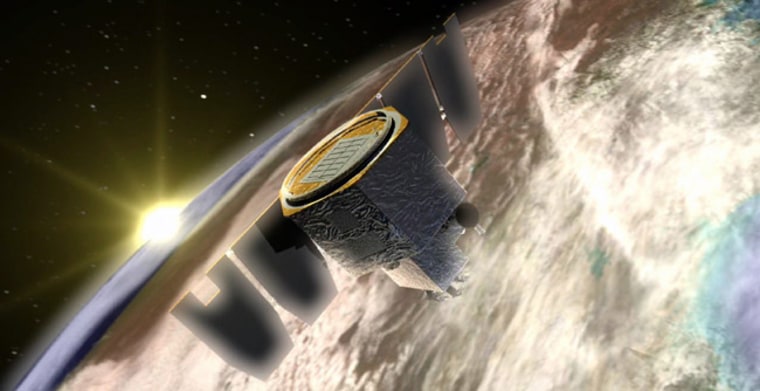A piano-sized NASA satellite was launched Wednesday on a mission that, astronomers hope, will reveal the unsolved mysteries of Earth’s highest clouds.
The Orbital Sciences-built Aeronomy of Ice in the Mesosphere (AIM) spacecraft is on a two-year mission to scan noctilucent, or ‘night-shining,’ clouds that can only observed after sunset. An air-launched Pegasus XL booster rocketed skyward from California's Vandenberg Air Force base shortly before 4:23 p.m. EDT.
“We are exploring clouds that literally are at the very edge of space,” James Russell, AIM’s principal investigator at Hampton University in Hampton, Virginia, said in a prelaunch mission briefing.
Also known as Polar Mesospheric Clouds (PMCs), noctilucent clouds are made up of ice crystals and hover some 50 miles (80 kilometers) above the surface of the Earth. The cloudy phenomena tend to be seen above the Earth’s polar regions and have been observed from the ground and space, though not at the levels of detail expected from AIM, researchers said.
“This mission is the first mission dedicated to the study of noctilucent clouds,” Russell said. “We have observed them with satellites [in the past], and all it’s done is left us wanting.”
Ice cloud oddities
Researchers first observed noctilucent clouds in 1885 following the eruption of the Krakatoa volcano, though the exact nature of their genesis remains a mystery. Added to the pot is the clouds’ odd increase in frequency in recent years, sometimes in regions previously void of such displays, prompting some researchers to link their formation to worldwide climate changes such as global warming.
“It’s a natural question to ask ‘Why are we seeing them now when we haven’t before,’” Russell said.
{
"type": "Slideshow",
"element": null,
"html": null,
"ecommerceEnabled": false
}“They’re brighter in the north than in the south, for example,” Russell said.
Similar clouds have been observed high above the surface of Mars, leading researchers to believe that a better understanding of the phenomena will aid future missions to the red planet by yielding fundamental knowledge on the interaction of the Sun’s energy and planetary atmospheres.
"These clouds are indicators of conditions in the upper reaches of the Earth's atmosphere, and are an important link in the chain of processes that result in the deposition of solar energy into Earth's atmosphere," Mary Mellott, AIM program scientist, NASA’s Washington D.C. headquarters, said in a statement. "AIM will provide an understanding of how and why these clouds form, an important contribution toward the NASA goals of understanding the fundamental physical processes of our space environment and how the habitability of planets is affected by the interaction of planetary magnetic fields and atmospheres with solar variability."
Scanning the mesosphere
The 430-pound (195-kilogram) AIM spacecraft carries three primary tools to scan the highest clouds on the planet:
The Cloud Imaging and Particle Size (CIPS) is laden with four cameras, each positioned at a different angle, to return two-dimensional images at noctilucent clouds that are expected to yield sizes for the ice particles in each formation and generate a daily panorama of the polar ice cap.
The Solar Occultation for Ice Experiment (SOFIE) is designed to measure the particles, temperatures atmospheric gases that make up each cloud to reveal their chemical composition and formation environment.
The Cosmic Dust Experiment is designed to record the amount of interstellar dust that enters the Earth’s atmosphere so researchers can study its role in noctilucent cloud formation.
Together, the instruments are designed to tackle six primary target areas that include long-term changes in the Earth’s upper atmosphere, temperature variations, hydrogen chemistry, and the influence of gravity waves on cloud formation. They will scan clouds in the Earth’s mesosphere, a region of the atmosphere that sits above the stratosphere.
The spacecraft relies on six solar panels, wrapped around the probe at launch, to generate the 216 watts of power required to support its science instruments.
“The whole deployment sequence takes about 20 minutes,” said Chris Savinell, NASA’s AIM mission manager at the agency’s Goddard Space Flight Center in Greenbelt, Maryland, in a preflight briefing.
AIM is one of NASA’s Small Explorer missions designed to develop relatively low-cost space science and exploration expeditions.
"This Small Explorer mission is a good example of the huge science returns we can get for a relatively small cost investment," said Vicki Elsbernd, NASA’s AIM program executive, in a statement.
